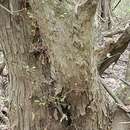en
names in breadcrumbs


Planera is a genus of flowering plants with a single living species, Planera aquatica,[1] the planertree[2] or water elm. The genus has an extensive fossil record dating back to the Cretaceous and spanning the northern hemisphere, with a few southern hemisphere records as well.[3] The living species is found in the southeastern United States, it is a small deciduous tree 10–15 m (390–590 in) tall, closely related to the elms but with a softly, prickly nut 10–15 mm (0.39–0.59 in) diameter, instead of a winged seed. It grows, as the name suggests, on wet sites. Despite its common English name, this species is not a true elm, although it is a close relative of the elms (species of the genus Ulmus). It is also subject to Dutch elm disease, a disease which affects only members of the Ulmaceae. It is native to most of the southeast United States. It is hardy down to Zone 7.[4]
Planera is a genus of flowering plants with a single living species, Planera aquatica, the planertree or water elm. The genus has an extensive fossil record dating back to the Cretaceous and spanning the northern hemisphere, with a few southern hemisphere records as well. The living species is found in the southeastern United States, it is a small deciduous tree 10–15 m (390–590 in) tall, closely related to the elms but with a softly, prickly nut 10–15 mm (0.39–0.59 in) diameter, instead of a winged seed. It grows, as the name suggests, on wet sites. Despite its common English name, this species is not a true elm, although it is a close relative of the elms (species of the genus Ulmus). It is also subject to Dutch elm disease, a disease which affects only members of the Ulmaceae. It is native to most of the southeast United States. It is hardy down to Zone 7.